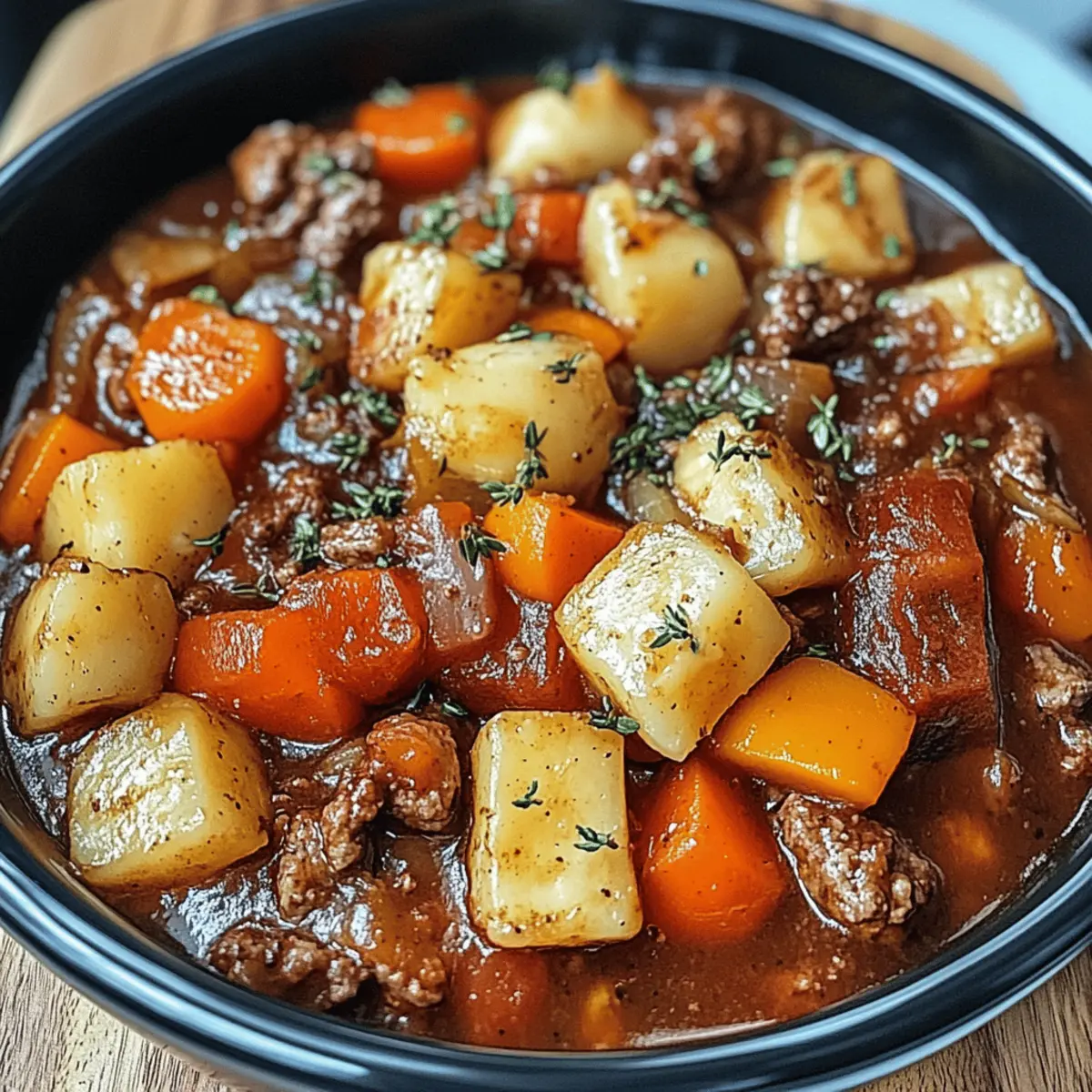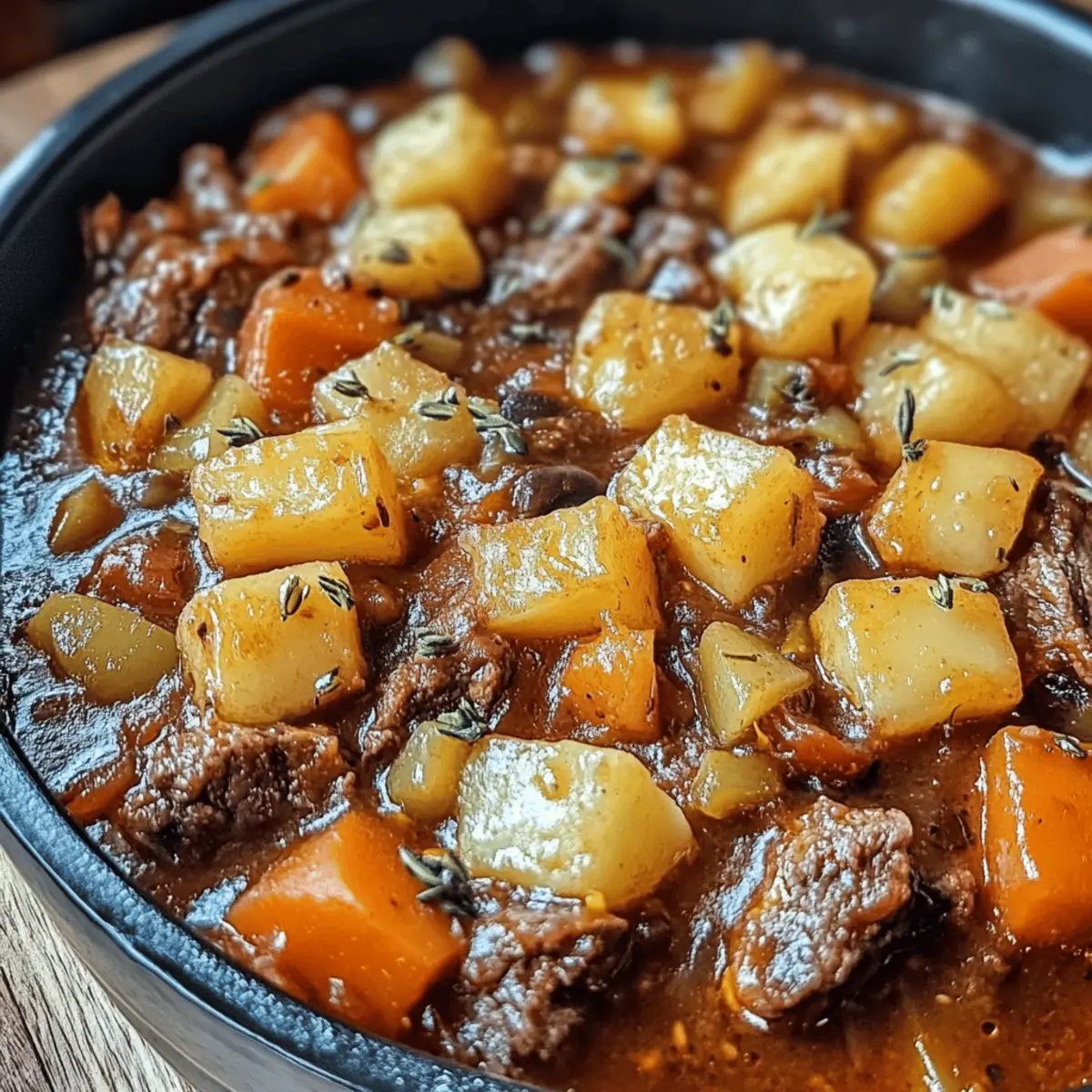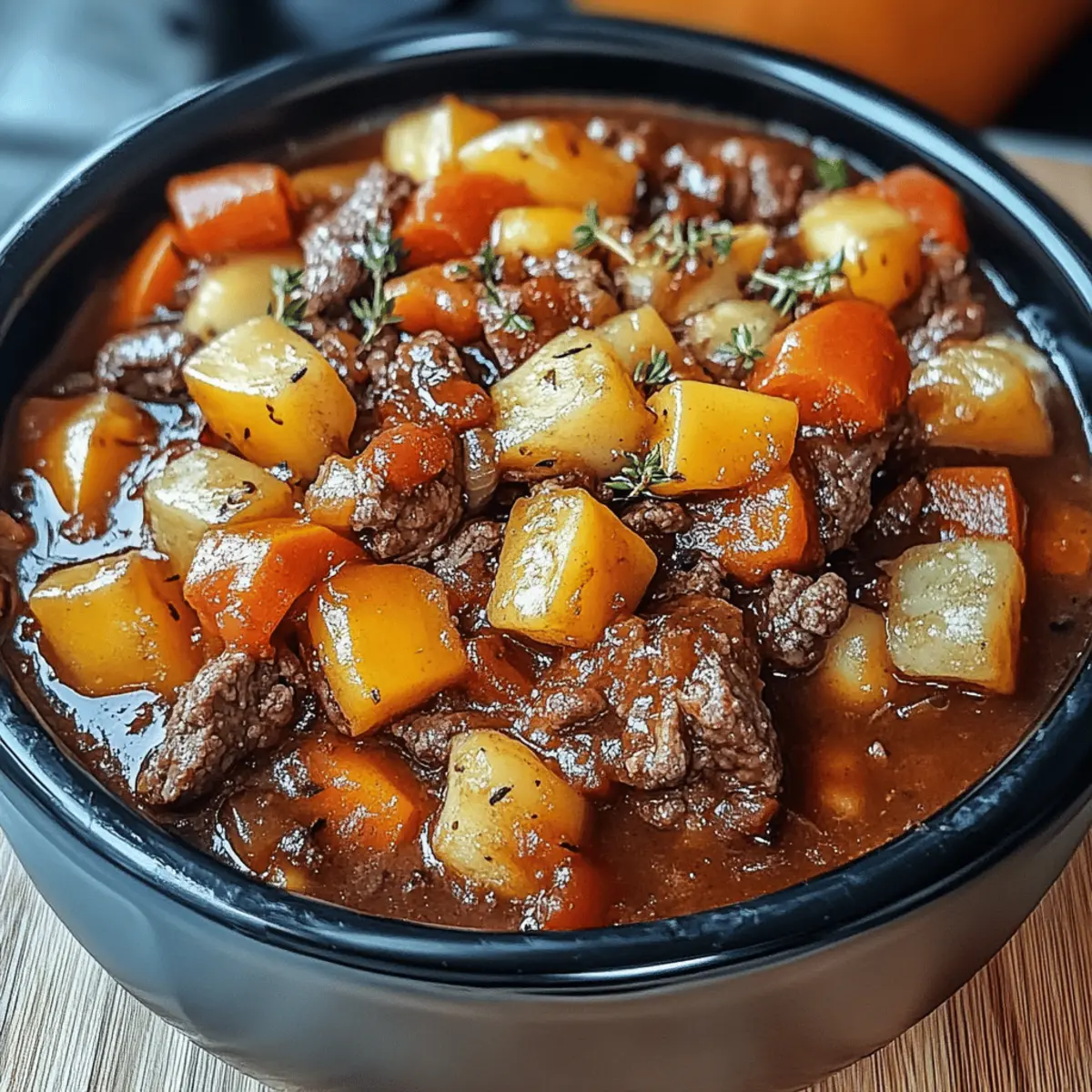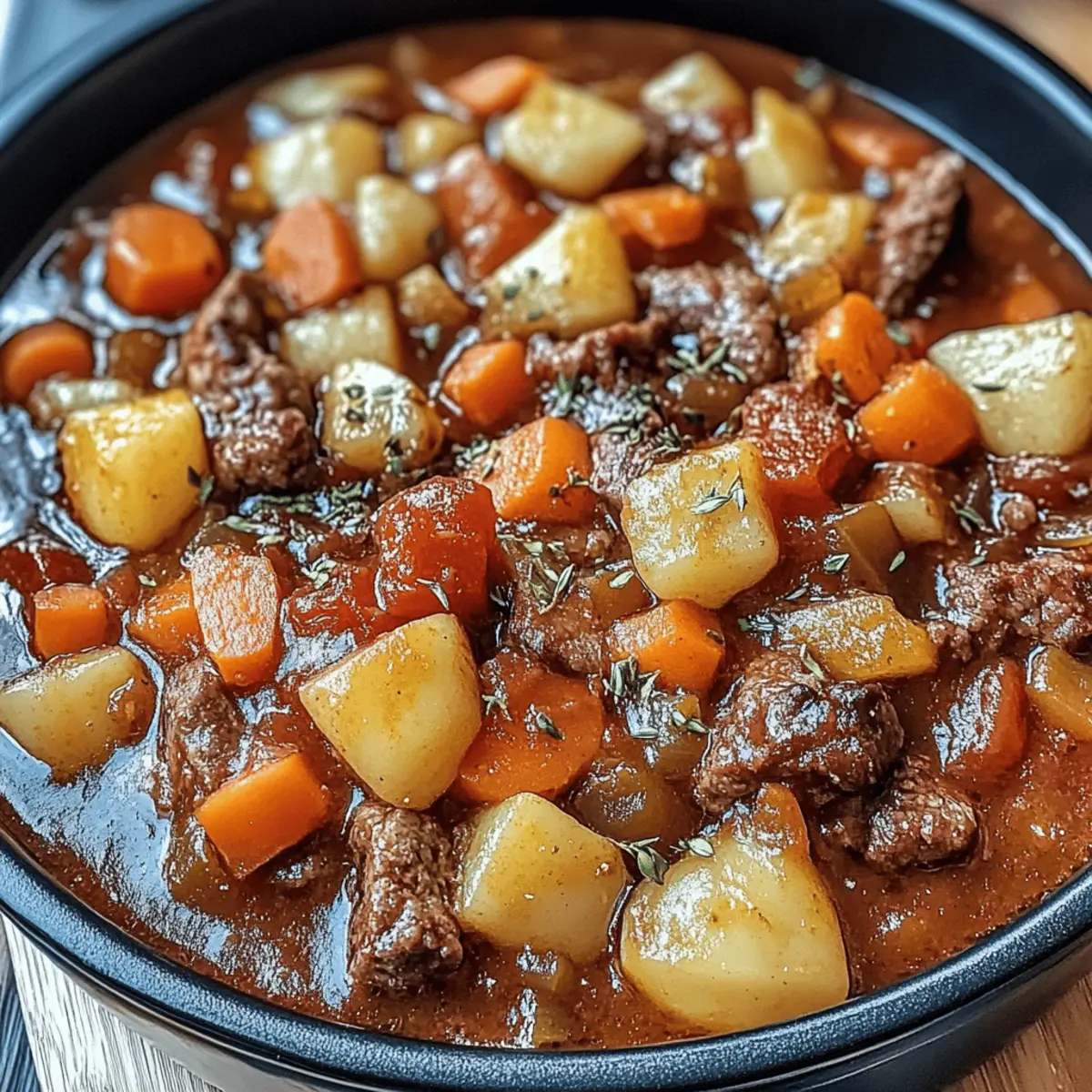There’s something about the warm embrace of homemade Beef Stew that takes me back to my childhood kitchen, where the rich aroma filled every corner. Cooking this hearty comfort food is not just about nourishing the body; it’s a way to gather friends and family around the table, sharing stories and laughter. With its effortless gluten-free option, this stew is perfect for everyone, making it an instant crowd-pleaser. The best part? You can whip it up with just 15 minutes of prep, leaving you free to savor those moments while it simmers to perfection. Are you ready to bring a little warmth to your kitchen with this delicious recipe?
Why is Homemade Beef Stew Irresistible?
Comforting Warmth: There’s nothing quite like the rich, hearty flavors of homemade beef stew to make you feel at home. Easy Preparation: With just 15 minutes of prep time, you can create a delicious meal that simmers to perfection while you relax. Gluten-Free Option: This recipe is versatile, featuring a gluten-free alternative to cater to all diets. Flavorful Ingredients: The combination of thyme, garlic, and Worcestershire sauce elevates this dish into a comforting classic. Crowd-Pleasing Delight: Perfect for family gatherings, this stew invites everyone to share stories like “Sunday Suppers.” Pair it with crusty bread or creamy mashed potatoes for an unforgettable meal.
Ingredients
- For the Beef Stew
• Beef chuck roast – a tender cut that, when slow-cooked, becomes melt-in-your-mouth delicious.
• Kosher salt – enhances the natural flavors of the beef, making each bite savory.
• Coarsely ground black pepper – adds just the right amount of warmth and spice.
• Gluten-free all-purpose flour – vital for coating the beef and thickening the stew; substitute with whole wheat if preferred.
• Olive oil – for searing the beef, brings richness and improves flavor.
• Yellow onion – provides a sweet base flavor; try using a sweet onion for a twist.
• Garlic – freshly minced garlic adds an aromatic depth that’s irresistible.
• Carrot – adds sweetness and color; feel free to mix in parsnips for added flavor.
• Yukon Gold potatoes – creamy texture that thickens the stew wonderfully; you can use russet potatoes if needed.
• Beef broth – the core liquid that melds all the flavors together beautifully.
• Tomato paste – gives a subtle acidity that brightens up the flavor profile.
• Worcestershire sauce – adds a complex umami flavor, making your beef stew truly special.
• Bay leaf – infuses the stew with a delicate herbal note; remember to remove it before serving.
• Fresh thyme – adds a fragrant touch; feel free to use dried thyme if fresh isn’t on hand, just use less.
Enjoy creating this hearty Beef Stew that warms both the heart and the home!
Step‑by‑Step Instructions for Homemade Beef Stew
Step 1: Prepare the Beef
Begin by seasoning your beef chuck roast chunks with kosher salt and coarsely ground black pepper. Next, sprinkle the gluten-free flour over the meat, tossing well to ensure each piece is evenly coated. This step not only enhances flavor but also helps thicken the stew as it cooks.
Step 2: Brown the Beef
In a large Dutch oven or heavy-bottomed pot, heat the olive oil over medium heat. Working in batches, add the seasoned beef to the pot, browning it on all sides for about 3–4 minutes per batch. This step creates a deep flavor base for your beef stew, so avoid overcrowding the pot; transfer the browned beef to a plate and set aside.
Step 3: Sauté the Vegetables
With the pot still over medium heat, add the chopped yellow onion, minced garlic, and carrot to the drippings left in the pot. Cook for 2–3 minutes, stirring occasionally until the vegetables start to soften and develop a slight golden color. This process sweetens the onions and adds richness to your homemade beef stew.
Step 4: Combine Ingredients
Add the diced Yukon Gold potatoes, beef broth, tomato paste, Worcestershire sauce, bay leaf, and fresh thyme to the pot. Stir everything together thoroughly, scraping up the flavorful brown bits from the bottom of the pot. This mixture will form the heart of your beef stew, blending all the flavors beautifully.
Step 5: Return the Beef
Carefully return the browned beef chunks to the pot, ensuring they’re nestled among the vegetables and liquid. Bring the mixture to a gentle simmer, allowing the flavors to meld together. This simmering step is crucial as it infuses the beef stew with all the savory goodness from the ingredients.
Step 6: Oven Slow Cooking
Cover the Dutch oven with a lid and transfer it to a preheated oven set at 325°F (163°C). Let your homemade beef stew cook for 2 to 2½ hours, checking for doneness. The stew is ready when the beef is fall-apart tender and the entire dish has thickened into a hearty, comforting meal.
Step 7: Final Touches
Once cooked, remove the beef stew from the oven and discard the bay leaf. Taste the stew, adjusting seasoning as necessary with additional salt and pepper. This step ensures every bite is savory and satisfying while highlighting the rich flavors developed during cooking.
Step 8: Serve and Enjoy
Ladle the steaming beef stew into bowls and garnish with a sprinkle of fresh thyme for a touch of color. Serve warm, ideally with a slice of crusty bread or over creamy mashed potatoes. This hearty meal is perfect for gathering loved ones and sharing in the cozy warmth of homemade comfort food.
How to Store and Freeze Beef Stew
Fridge: Store beef stew in an airtight container in the refrigerator for up to 3 days. Let it cool completely before sealing to preserve freshness.
Freezer: For longer storage, freeze the beef stew in a heavy-duty freezer bag or container for up to 3 months. Leave space for expansion and label with the date.
Thawing: To safely thaw, place the frozen beef stew in the fridge overnight or use the microwave defrost setting. Avoid leaving it out at room temperature.
Reheating: Reheat the stew on the stovetop over medium heat until warmed through, stirring occasionally. You can add a splash of beef broth to loosen the consistency if needed.
What to Serve with Homemade Beef Stew
There's a comforting warmth in enjoying your beef stew alongside delicious accompaniments that truly enhance the meal experience.
- Crusty Bread: Perfect for soaking up every savory drop, a warm slice of crusty bread invites rich flavors to dance on your palate.
- Creamy Mashed Potatoes: Silky and buttery, they provide a delightful contrast to the robust stew, making each bite even more satisfying.
- Garlic Roasted Brussels Sprouts: Their crispy edges and tender insides add a delightful crunch and a hint of earthiness to the meal.
- Steamed Green Beans: A fresh, vibrant addition, these crunchy green beans bring brightness to your plate and balance the meal beautifully.
- Side Salad: A light, mixed green salad with vinaigrette offers a refreshing contrast to the hearty stew, cleansing your palate.
- Red Wine: A glass of full-bodied red wine complements the richness of the stew, enhancing its deep flavors while inviting relaxation.
- Homemade Apple Pie: End the meal on a sweet note! The warm, spiced flavors of apple pie create a nostalgic finish, perfect for cozy family gatherings.
Expert Tips for the Best Beef Stew
Browning is Key: Ensure you brown the beef chunks well to develop a rich, deep flavor base—don’t skip this step!
Avoid Overcrowding: Cook the beef in batches; overcrowding can result in steaming rather than browning, diminishing flavor.
Adjust Seasoning Later: Taste your beef stew before serving. Adjust seasoning to your liking—adding salt at the end can enhance flavors even more.
Thickening Techniques: For a thicker stew, consider adding more gluten-free flour or mashed potatoes towards the end of cooking.
Let It Rest: Allow the stew to sit for a few minutes after cooking; this helps the flavors meld beautifully, making your homemade beef stew even tastier!
Beef Stew Variations & Substitutions
Let your creativity shine in the kitchen by customizing this fabulous Beef Stew to suit your taste!
- Dairy-Free: Substitute any dairy-based butter or cream with coconut milk for a creamy texture without the dairy.
- Vegetarian Delight: Replace beef with hearty mushrooms, lentils, and vegetable broth for a plant-based version that’s just as satisfying.
- Extra Veggies: Toss in peas, corn, or green beans during the last 30 minutes of cooking for added color and nutrition.
- Spicy Kick: Add a pinch of red pepper flakes or chopped jalapeños to the stew for a warm, spicy twist that'll awaken your taste buds!
- Herb Infusion: Fresh rosemary or oregano can enhance the flavor profile; just add them to the pot along with thyme for savory depth.
- Sweet and Savory: A splash of balsamic vinegar or a spoonful of brown sugar will bring a subtle sweetness that beautifully balances the savory notes.
- Chunky or Smooth: For a thicker, smoother stew, blend a portion of the stew after cooking and mix it back in for a comforting texture.
- Hearty Grain Addition: Consider adding barley or quinoa in the last 30 minutes of cooking for added texture, fiber, and a delightful nutty flavor.
Feel free to play around with these ideas; after all, cooking is about enjoying the process and making it your own! You might also like to explore some delightful sides to pair with your creation, like creamy mashed potatoes or a fresh garden salad that adds a crisp contrast.
Make Ahead Options
These Homemade Beef Stew components are perfect for meal prep! You can season and brown the beef up to 24 hours in advance, storing it covered in the refrigerator to maintain its delicious flavors. Additionally, you can chop the vegetables (onions, carrots, and potatoes) and refrigerate them in an airtight container up to 3 days ahead, just be sure to add a splash of lemon juice to the potatoes to prevent browning. When you’re ready to serve, simply sauté the vegetables, reintroduce the beef, combine with the remaining ingredients, and let it simmer as directed. This approach not only saves you time but also ensures that your stew is just as hearty and flavorful when you finish cooking it!
Homemade Beef Stew Recipe FAQs
How do I choose ripe ingredients for my Beef Stew?
Absolutely! When selecting vegetables like potatoes and carrots, look for ones that are firm and free from dark spots or blemishes. For the beef, choose a chuck roast with good marbling, as the fat will make it tender and flavorful after slow cooking.
What’s the best way to store leftover Beef Stew?
For optimal freshness, store any leftover beef stew in an airtight container in the refrigerator for up to 3 days. Allow the stew to cool completely before sealing the container to maintain its quality. If you plan to keep it longer, consider freezing.
Can I freeze Beef Stew, and how should I do it?
Very! To freeze your beef stew, transfer it to a heavy-duty freezer bag, leaving about an inch of space at the top for expansion—this helps prevent freezer burn. Label the bag with the date and freeze it for up to 3 months. When you're ready to enjoy it again, thaw in the fridge overnight or use the microwave’s defrost setting instead of leaving it out at room temperature.
What if my Beef Stew is too thin?
No worries! If your stew isn’t as thick as you’d like, you can easily remedy this. Stir in a slurry made of equal parts water and gluten-free flour or cornstarch during the last 15-30 minutes of cooking. Alternatively, you can mash a few pieces of the potatoes in the stew to help thicken it naturally.
Is this Beef Stew safe for those with gluten allergies?
Yes! This recipe includes a gluten-free option by using gluten-free all-purpose flour for coating the beef. However, always double-check ingredient labels for any hidden gluten content, especially in beef broth and sauces like Worcestershire. If you prefer, you can substitute with a whole wheat flour if gluten is not a concern.
How can I improve the flavor of my Beef Stew?
Great question! To elevate the flavor, consider adding a splash of red wine or balsamic vinegar when combining the ingredients. Another tip is to sauté the onions longer for extra sweetness and depth before adding the other vegetables. Fresh herbs can really enhance the aroma and taste—don’t hesitate to use more fresh thyme or even parsley for garnish when serving!

Hearty Beef Stew for Ultimate Comfort Food Lovers
Equipment
- Dutch oven
- Cutting Board
- Knife
Ingredients
For the Beef Stew
- 2 lbs Beef chuck roast cut into chunks
- 1 tablespoon Kosher salt for seasoning
- 1 teaspoon Coarsely ground black pepper
- ¼ cup Gluten-free all-purpose flour for coating
- 2 tablespoon Olive oil for searing
- 1 large Yellow onion chopped
- 4 cloves Garlic minced
- 2 medium Carrot chopped
- 4 medium Yukon Gold potatoes diced
- 4 cups Beef broth
- 2 tablespoon Tomato paste
- 2 tablespoon Worcestershire sauce
- 1 leaf Bay leaf
- 2 sprigs Fresh thyme or dried thyme as substitute
Instructions
Step-by-Step Instructions for Homemade Beef Stew
- Season beef chuck roast chunks with kosher salt and coarsely ground black pepper, then sprinkle gluten-free flour over the meat, tossing well.
- In a Dutch oven, heat olive oil over medium heat, add seasoned beef in batches, browning on all sides for about 3–4 minutes.
- Add chopped yellow onion, minced garlic, and carrot to the pot, cooking for 2–3 minutes until softened and slightly golden.
- Add diced Yukon Gold potatoes, beef broth, tomato paste, Worcestershire sauce, bay leaf, and fresh thyme, stirring thoroughly.
- Return browned beef to the pot, and bring to a gentle simmer to meld flavors.
- Cover the Dutch oven and transfer it to a preheated oven set at 325°F (163°C) for 2 to 2½ hours.
- Remove from oven, discard bay leaf, adjust seasoning with salt and pepper as needed.
- Ladle stew into bowls, garnish with fresh thyme, and serve warm.







